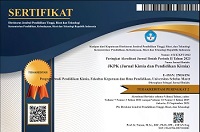The Effect of Paras Stone Green Coagulant Preparation and Test Solution Concentration on Azo Dye Removal
Abstract
Paras Stone, a volcanic clay rich in silica (SiO₂) and widely used in Lombok, West Nusa Tenggara (NTB), for sculptures, tombstones, and decorative ornaments, produces significant residual waste during carving. This waste can be repurposed as a natural coagulant for wastewater treatment, though research on its local application remains limited. Azo dyes, particularly prevalent in the textile industry, are produced at an estimated 700,000 tons annually, with 10–15% discharged into wastewater streams, posing serious environmental risks due to their toxic and non-biodegradable nature. This study investigates the removal efficiency of Remazol Red azo dye using Paras Stone under three conditions: non-activated, physically activated, and chemically activated with HCl or H₂SO₄. Chemical activation involved immersing Paras Stone in 3 M HCl or 0.1 M H₂SO₄ solutions with stirring for 2 hours, then rinsing to neutral pH and drying. Coagulation–flocculation experiments were conducted in batch mode, consisting of a 4-minute and 20-minute coagulation phase. The results demonstrated that non-activated Paras Stone achieved the highest dye removal efficiency (95.50%), surpassing samples activated with HCl (91.57%) and H₂SO₄ (92.53%). ANOVA analysis confirmed these differences as statistically significant at the 95% confidence level. The optimum conditions were obtained with a coagulant dose of 2.75 g of Paras Stone and 2.00 g of Opuntia ficus-indica gel, applied at a Remazol Red solution concentration of 30 mg/L. The O. ficus-indica gel, prepared by extracting parenchyma tissue, grinding, centrifuging, and collecting the gel-like supernatant, was a natural flocculant that facilitated the formation of larger flocs and accelerated sedimentation. These findings indicate that non-activated Paras Stone offers an effective, low-cost, and environmentally sustainable alternative for removing azo dyes in textile wastewater treatment.
Keywords
Full Text:
PDFReferences
[1] S. Lamusiah, “Estetika ragam hias batik sasambodi sentral kerajinan SMK 5 Pagesangan Mataram,” Paedagoria FKIP UMMAT, vol. 6, no. 1, pp. 88–99, 2018, doi: https://doi.org/10.31764/paedagoria.v6i1.146.
[2] Naghizadeh and R. Nabizadeh, “Removal of reactive blue 29 dye by adsorption on modified chitosan in the presence of hydrogen peroxide,” Environ. Prot. Eng., vol. 42, no. 1, pp. 149–168, 2016, doi: https://doi.org/10.5277/epl160112.
[3] S. Benkhaya, S. M’rabet, and A. El Harfi, “Classifications, properties, recent synthesis and applications of azo dyes,” Heliyon, vol. 6, no. 1, p. e03271, 2020, doi: https: //doi.org/10.1016/j.heliyon.2020.e03271
[4] B. Kamenická, “Chemical degradation of azo dyes using different reducing agents: A review,” J. Water Process Eng., vol. 61, p. 105350, 2024, doi: https://doi.org/10.1016/j.jwpe.2024.105350
[5] Rizki, N. N. Aprilia, and M. Fitriyan, “Penerapan prinsip interaksi antarmolekul dalam pengolahan limbah batik,” J. Tadris Kimia IAIN Syekh Nurjati Cirebon, vol. 2, no. 01, pp. 19–28, 2023.
[6] M. T. Yagub, T. K. Sen, S. Afroze, and H. M. Ang, “Dye and its removal from aqueous solution by adsorption: A review,” Adv. Colloid Interface Sci., vol. 209, pp. 172–184, 2014, doi: https://doi.org/10.1016/j.cis.2014.04.002
[7] R. Safitri, M. Miranti, S. R. Rahayuningsih, T. Widjastuti, R. Balia, and J. Nurhayati, “Biodegradation of black and Remazol red textile dyes by bacterial strains isolated from river contaminated textile dyes effluent,” Earth Observ., vol. 9, pp. 183–192, 2020.
[8] B. J. Brüschweiler and C. Merlot, “Azo dyes in clothing textiles can be cleaved into a series of mutagenic aromatic amines which are not regulated yet,” Regul. Toxicol. Pharmacol., vol. 88, pp. 214–226, 2017, doi: https://doi.org/10.1016/j.yrtph.2017.06.012
[9] H. Alzain, V. Kalimugogo, and K. Hussein, “A review of environmental impact of azo dyes,” Int. J. Res. Rev., vol. 10, no. 6, pp. 64–689, 2023. Doi: https://doi.org/10.52403/ijrr.20230682
[10] M. Ikram et al., “Bacillus subtilis: As an efficient bacterial strain for the reclamation of water loaded with textile azo dye, orange II,” Int. J. Mol. Sci., vol. 23, no. 18, p. 10637, 2022, doi: https://doi.org/10.3390/ijms231810637
[11] Y. Wang et al., “Research status, trends, and mechanisms of biochar adsorption for wastewater treatment: A scientometric review,” Environ. Sci. Eur., vol. 36, no. 1, pp. 1–17, 2024, doi:
https://doi.org/10.1186/s12302-024-00859-z
[12] A. Elgarahy et al., “A critical review of biosorption of dyes, heavy metals and metalloids from wastewater as an efficient and green process,” Clean. Eng. Technol., vol. 4, p. 100209, 2021, doi: https://doi.org/10.1016/j.clet.2021.100209
[13] P. Manickam and D. Vijay, “Chemical hazards in textiles,” in Elsevier eBooks, pp. 19–52, 2021, doi: https://doi.org/10.1016/B978-0-12-820494-8.00002-2
[14] R. Kishor et al., “Ecotoxicological and health concerns of persistent coloring pollutants of textile industry wastewater and treatment approaches for environmental safety,” J. Environ. Chem. Eng., vol. 9, no. 2, p. 105012, 2021, doi: https://doi.org/10.1016/j.jece.2020.105012
[15] Q. Wiqoyah and A. B. P. Aji, “Pemanfaatan limbah batu paras untuk memperbaiki kuat geser tanah lempung Bayat Klaten,” Simp. Nas. RAPI XXI, vol. 21, pp. 307–314, 2023.
[16] A. Shofiyani and Y. Rahmiyati, “Nanosilika berbahan dasar batu padas sebagai adsorben zat warna sintetis rhodamin B,” Indones. J. Chem. Sci., vol. 9, no. 3, pp. 187–193, 2020, doi: https://doi.org/10.15294/ijcs.v9i3.42027
[17] N. Octaviani et al., “Analisis kandungan Opuntia ficus‑indica (kaktus pir berduri) dalam pengolahan air,” J. Keselamatan Kesehatan Kerja dan Lingkungan, vol. 4, no. 2, pp. 147–150, 2023, doi: https://doi.org/10.25077/jk3l.4.2.147-150.2023
[18] M. Martins, M. H. Ribeiro, and C. M. M. Almeida, “Physicochemical, nutritional and medicinal properties of Opuntia ficus‑indica (L.) Mill and its main agro‑industrial use: A review,” Plants, vol. 12, no. 7, pp. 1–45, 2023, doi: https://doi.org/10.3390/plants12071512
[19] D. Prisa, “Opuntia ficus‑indica the key plant in climate change: Characteristics, cultivation and uses,” GSC Biol. Pharm. Sci., vol. 17, no. 2, pp. 094–105, 2021, doi: https://doi.org/10.30574/gscbps.2021.17.2.0333
[20] W. H. Bergland et al., “High rate manure supernatant digestion,” Water Res., vol. 76, pp. 1–9, 2015, doi: https://doi.org/10.1016/j.watres.2015.02.051
[21] J. Bratby, Coagulation and Flocculation in Water and Wastewater Treatment, vol. 15, London, U.K.: IWA Publishing, 2016.
[22] N. R. Atandawu and I. A. G. Widihati, “Adsorpsi kation Pb(II) dan Cr(III) oleh batu padas jenis ladgestone teraktivasi H₂SO₄ dan NaOH,” J. Kimia, vol. 7, no. 2, pp. 202–210, 2013.
[23] A. A. I. A. M. Laksmiwati and P. Suarya, “Aktivasi batu padas dengan asam dan pemanfaatannya sebagai penyerap limbah deterjen,” J. Media Sains, vol. 1, no. 1, pp. 1–6, 2017, doi: https://doi.org/10.36002/jms.v1i1.188
[24] W. S. Atikah, “Potensi zeolit alam Gunung Kidul teraktivasi sebagai media adsorben pewarna tekstil,” Arena Tekstil, vol. 32, no. 1, pp. 17–24, 2017, doi: https://doi.org/10.31266/at.v32i1.2650
[25] Y. D. Ngapa, “Study of the acid‑base effect on zeolite activation and its characterization as adsorbent of methylene blue dye,” JKPK (J. Kim. Pendidik. Kim.), vol. 2, no. 2, pp. 90–96, 2017, doi: https://doi.org/10.20961/jkpk.v2i2.11904
[26] A. Dalvand et al., “Application of chemical coagulation process for direct dye removal from textile wastewater,” J. Environ. Health Sustain. Dev., vol. 2, no. 3, pp. 333–339, 2017.
[27] X. Huang et al., “Compound bioflocculant used as a coagulation aid in synthetic dye wastewater treatment: The effect of solution pH,” Sep. Purif. Technol., vol. 154, pp. 108–114, 2015, doi: https://doi.org/10.1016/j.seppur.2015.09.018
[28] S. Ihaddaden et al., “Removal of methylene blue (basic dye) by coagulation‑flocculation with biomaterials (bentonite and Opuntia ficus‑indica),” J. Water Process Eng., vol. 49, p. 102952, 2022, doi: https://doi.org/10.1016/j.jwpe.2022.102952
[29] M. Choudhary, M. B. Ray, and S. Neogi, “Evaluation of the potential application of cactus (Opuntia ficus‑indica) as a bio‑coagulant for pre‑treatment of oil sands process‑affected water,” Sep. Purif. Technol., vol. 209, pp. 714–724, 2019, doi: https://doi.org/10.1016/j.seppur.2018.09.033
[30] T. K. F. S. Freitas et al., “Optimization of coagulation‑flocculation process for treatment of industrial textile wastewater using okra (A. esculentus) mucilage as natural coagulant,” Ind. Crops Prod., vol. 76, pp. 538–544, 2015, doi: https://doi.org/10.1016/j.indcrop.2015.06.027
[31] Q. Wei et al., “Eco‑friendly decolorization of cationic dyes by coagulation using natural coagulant bentonite and biodegradable flocculant sodium alginate,” SDRP J. Earth Sci. Environ. Stud., vol. 5, no. 2, pp. 51–60, 2020, doi: https://doi.org/10.25177/JESES.5.2.RA.10648
[32] E. Fosso‑Kankeu, A. Webster, I. O. Ntwampe, and F. B. Waanders, “Coagulation/flocculation potential of polyaluminium chloride and bentonite clay tested in the removal of methyl red and crystal violet,” Arab. J. Sci. Eng., vol. 42, no. 4, pp. 1389–1397, 2017, doi: https://doi.org/10.1007/s13369-016-2244-x
[33] N. M. Daud et al., “Coagulation‑flocculation treatment for batik effluent as a baseline study for the upcoming application of green coagulants/flocculants towards sustainable batik industry,” Heliyon, vol. 9, no. 6, p. e17284, 2023, doi: https://doi.org/10.1016/j.heliyon.2023.e17284
[34] K. O. Iwuozor, “Prospects and challenges of using coagulation‑flocculation method in the treatment of effluents,” Adv. J. Chem.—Sect. A, vol. 2, no. 2, pp. 105–127, 2019, doi: https://doi.org/10.29088/SAMI/AJCA.2019.2.105127
[35] R. M. El‑Taweel et al., “A review of coagulation explaining its definition, mechanism, coagulant types, and optimization models; RSM, and ANN,” Curr. Res. Green Sustain. Chem., 2023, doi: https://doi.org/10.1016/j.crgsc.2023.100358
[36] D. S. Asmorowati, I. I. Kristanti, and S. S. Sumarti, “Adsorpsi logam Fe pada limbah laboratorium kimia menggunakan zeolit alam teraktivasi asam sulfat,” Indones. J. Chem. Sci., vol. 12, no. 1, pp. 16–21, 2023.
[37] S. Stambouli‑Essassi et al., “Evaluation of the efficiency of Opuntia ficus‑indica cladode cuttings for vegetative multiplication,” Not. Bot. Horti Agrobot. Cluj‑Napoca, vol. 43, no. 2, pp. 521–527, 2015, doi: https://doi.org/10.15835/nbha43210049
[38] A. Khan, P. Ju, Z. Han, and C. Ni, “A comprehensive review on adsorptive removal of azo dyes using functional materials,” AQUA—Water Infrastruct. Ecosyst. Soc., vol. 73, no. 2, pp. 266–285, 2024, doi: https://doi.org/10.2166/aqua.2024.292
[39] R. Sasri, L. Destiarti, and I. Syahbanu, “Analisis ukuran partikel silika hasil ekstraksi dari batu padas asal Kabupaten Ketapang Kalimantan Barat,” Indones. J. Pure Appl. Chem., vol. 1, no. 1, pp. 39–43, 2018, doi: https://doi.org/10.26418/indonesian.v1i1.26042
[40] A. Ghofur and A. Hadi, “Karakterisasi fly ash batubara sebagai bahan katalitik konverter dalam mereduksi gas buang HC dan CO kendaraan bermotor,” Pros. SNST, vol. 1, no. 1, pp. 33–37, 2014, doi: https://doi.org/10.36499/psnst.v1i1.971
[41] S. Wang and Y. Peng, “Natural zeolites as effective adsorbents in water and wastewater treatment,” Chem. Eng. J., vol. 156, no. 1, pp. 11–24, 2010, doi: https://doi.org/10.1016/j.cej.2009.10.029
[42] A. A. Siyal et al., “Adsorption kinetics, isotherms, and thermodynamics of removal of anionic surfactant from aqueous solution using fly ash,” Water Air Soil Pollut., vol. 231, no. 509, pp. 1–13, 2020, doi: https://doi.org/10.1007/s11270-020-04879-2
[43] H. Li, Z. A. Zhou, Z. Xu, and J. H. Masliyah, “Role of acidified sodium silicate in low temperature bitumen extraction from poor‑processing oil sand ores,” Ind. Eng. Chem. Res., vol. 44, no. 13, pp. 4753–4761, 2005, doi: https://doi.org/10.1021/ie048998k
[44] N. Saksono, L. Puspita, and T. Sukreni, “Application of contact glow discharge electrolysis method for degradation of batik dye waste Remazol red by the addition of Fe²⁺ ion,” AIP Conf. Proc., vol. 1821, p. 020003, 2017, doi: https://doi.org/10.1063/1.4978076
[45] S. H. Hashemi and M. Kaykhaii, “Azo dyes: Sources, occurrence, toxicity, sampling, analysis, and their removal methods,” in Emerg. Freshwater Pollut., pp. 267–287, 2022, doi: https://doi.org/10.1016/B978-0-12-822850-0.00013-2
[46] R. A. Safitri and M. Rahmayanti, “Characterization and application of chitosan as a natural coagulant in reducing Remazol red dyestuff concentration and COD value of batik liquid waste,” J. Kim. Sains Apl., vol. 23, no. 9, pp. 333–337, 2020, doi: https://doi.org/10.14710/jksa.23.9.333-337
[47] M. Rahmayanti, I. Nurhikmah, and F. Larasati, “Isolation, characterization and application of humin from Sumatran peat soils as adsorbent for naphthol blue black and indigosol blue dyes,” Molekul, vol. 16, no. 1, pp. 67–74, 2021, doi: https://doi.org/10.20884/1.jm.2021.16.1.700
[48] S. Hulwati, Q. Fardiyah, B. Rumhayati, and V. D. Aggraini, “The study of removal of Remazol red with biomaterial paras stone and Opuntia ficus‑indica by coagulation–flocculation,” Indones. J. Chem., vol. 25, no. 2, pp. 561–574, 2025, doi: https://doi.org/10.22146/ijc.102760
[49] V. M. I. Dewi and M. Rahmayanti, “The interaction mechanism of papaya seeds (Carica papaya L.) as a natural coagulant and Remazol red under different pH conditions,” Indo J. Chem. Res., vol. 10, no. 1, pp. 14–18, 2022, doi: https://doi.org/10.30598/ijcr.2022.10‑vin
[50] S. W. R. Pembayun and M. Rahmayanti, “Efektivitas biji asam jawa sebagai koagulan alami dalam menurunkan konsentrasi zat warna Remazol red dan nilai COD,” JST (J. Sains Teknol.), vol. 9, no. 2, pp. 162–169, 2020, doi: https://doi.org/10.23887/jstundiksha.v9i2.2817
Refbacks
- There are currently no refbacks.








